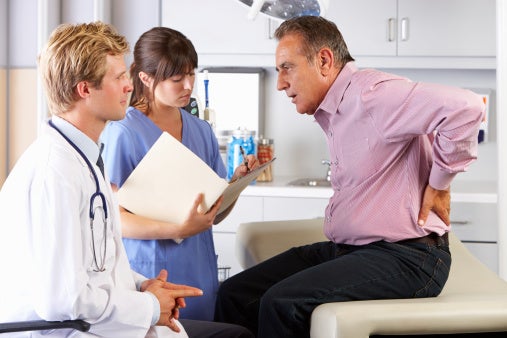Back Pain
Most of us experience lower back pain at some point in our lives. It’s a common complaint of middle-age and older adults, as well as for those who work in jobs that require heavy lifting and bending.
While most back pain is relieved by over-the-counter and prescription medication, rest, heat and physical therapy, sometimes surgery is needed to get relief from the pain and weakness.
WakeMed’s neurosurgeons and neurologists work in collaboration with other physicians, nurses, neuroradiologists and rehabilitation specialists to develop a personalized treatment plan for people coping with chronic back pain.
Symptoms of Back Pain
In addition to the back pain itself, other symptoms can include:
- Muscle aches
- Shooting or radiating pain down a leg
- Pain that worsens with movement
Types and Causes of Back Pain
Often, back pain is simply the result of poor posture or overuse. But it can also be caused by conditions including:
- Herniated disc, or slipped or ruptured disc, occurs when the soft center and outer lining that surrounds the disc tears, resulting in some of the gel-like substance to leak through the opening.
- Lumber spinal stenosis occurs when there is narrowing within the spinal canal. This results in pressure or compression on the nerves that run from the lower back through the legs. While some medical conditions can cause this, it usually happens due to the degeneration of discs. Patients can develop pain, numbness or weakness in the limbs on one or both sides of the body. More complex cases result in lost function in the legs, bladder or bowel.
- Degenerative spondylolisthesis and degenerative scoliosis can also cause spinal stenosis. In degenerative spondylolisthesis, the vertebrae can slip due to the effects of osteoarthritis. Degenerative scoliosis is seen more frequently in adults age 65 years and older. While it’s generally treated conservatively, severe curvature may need to be surgically corrected.
- Osteoarthritis is a breakdown of cartilage in the joints and often affects the lower back. Cartilage, a flexible and protective covering between bones and joints, helps reduce bone-to-bone contact. When it breaks down, patients develop pain and sometimes bone spurs. In the spine, this type of arthritis is called spondylosis. Age is the primary cause.
Diagnosing Back Pain
For patients experiencing chronic pain, doctors take a detailed history of symptoms and conduct a thorough physical examination to check for tenderness, numbness and pain in the back area.
We may also order imaging tests, including X-ray, computed tomography (CT) scan, magnetic resonance imaging (MRI), or nerve studies. These tests help us visualize the internal structures in the back, including nerves, spinal cord, bones and soft tissues.
Treating Back Pain
Most patients can control their pain with medication and therapy. We also offer comprehensive physical therapy services for back pain in many convenient locations. Learn more about our rehab and physical therapy services. Surgery can be the best option when patients:
- Have pain that limits their daily activities
- Are unable to stand or walk normally
- Experience persistent weakness and numbness
- Lose of bowel and bladder function
Surgery can repair the vertebrae, remove damaged discs or provide space in the spinal canal so that nerves are not pinched.
Make an Appointment
We welcome new patients. If you’d like to meet with one of WakeMed’s neurological experts about your back pain, please make an appointment by calling us at 919-350-7000.
